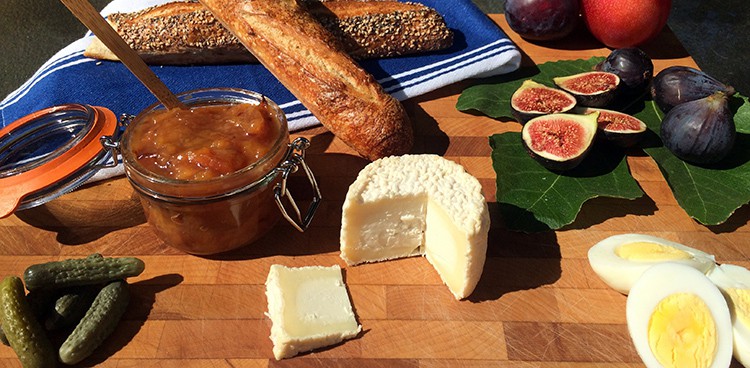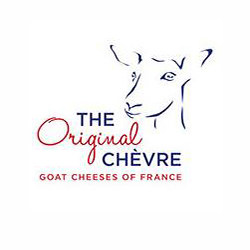
Welcome to Shaking Up Chèvre, a six-part collaboration between Goat Cheeses of France—the official US campaign for spreading the word on the tasty goodness of French chèvre— culture, and some amazing food bloggers. Our mission? To hand down tips and tricks on how to cook with and pair French goat’s milk cheeses! In this post, food writer and photographer Anya Soltero of Cooking with Caleb tackles Le Chevrot and Chèvre d’Argental. Missed Monday’s post on Selles-sur-Cher and Florette? Check it out.
Autumn is fast approaching and I am reluctantly, stubbornly bidding farewell to the summer months and their bounty of stone fruit, heirloom and other vine-ripened tomatoes, alfresco feasts on the back patio, chilled wine, and warm, enveloping days that feel almost endless.
With this seasonal scene-change afoot, I have been searching for that key ingredient for a family meal that would symbolize this transition, while simultaneously chasing after two energetic children, holding down some semblance of a career, folding laundry, composing long to-do lists, running errands, and attempting to hold a conversation thread with my husband. Goat cheese (chèvre) was the emblematic ingredient I was seeking. For me, fresh chèvre is evocative of spring’s beginning—goat kids bounding around the farm and new growth stretching toward sunlight—while aged chèvre is symbolic of summer’s end and fall’s beginning—rich autumnal hues replacing bright, brilliant summer sun. Right here, right now.
As a homage to this season of change, and with goat cheese on the brain, I set out to showcase two exceptional examples of aged French chèvre, creating a distinctive, vibrant, and delicious meal around each.

Act One: Le Chevrot. A ploughman’s board featuring Le Chevrot—soft-ripened with a dense interior, surrounded by a rich creamline and textured rind—accompanied by homemade stone fruit chutney. I also included fresh figs from our tree, pluots, hard-boiled eggs, cornichons, olives, and baguette. Inspired by a traditional ploughman’s lunch, this quintessential cast of seasonal ingredients can be enjoyed as a relaxed late-summer lunch or as a hearty opening act for dinner alfresco. To create the ploughman’s board, simply assemble the above-mentioned ingredients (or curate a selection of your choosing) on a rustic cheese board or platter.

Act Two: Chèvre d’Argental. An unforgettable pasta recipe that balances a creamy, cheese-laden sauce with bright flavors of late summer’s harvest. This entrée showcases Chèvre d’Argental—a Brie-like cheese produced in the Rhône-Alpes, possessing a bloomy rind and velvety interior—slow-roasted Early Girl tomatoes, and fragrant summer basil. Begging to be served in late summer, alfresco, this recipe is inspired by The New Basics Cookbook recipe by Rosso & Lukins—it has been one of my highly coveted scene-stealers for years. Such a recipe deserves to be honored with extraordinary cheese.
The Final Act. Both the ploughman’s board (featuring the perfect pairing of Le Chevrot and stone fruit chutney) and the rich, creamy pasta (boasting Chèvre d’Argental and slow-roasted Early Girls) call for back patio ambiance—a finely set table, the setting sun, and an eager audience with expectant appetites, under the golden kiss of dusk. This is how I enjoyed the labor of my seasonal change ruminations, in the company of appreciative family members under the fig tree, in the soft light of the setting sun. And oh man, was that meal worthy of an encore!

Stone Fruit Chutney
Note the sweet aroma of roasting stone fruit emanating from the oven. This chutney is the perfect companion to fresh or aged chèvre. Can be made one day ahead.
Ingredients:
- 5 large, firm, ripe organic peaches and/or nectarines (approx. 12 oz), pitted and sliced in large chunks
- 1½ tablespoons canola oil
- 5 tablespoons sugar
- 3 tablespoons white balsamic vinegar
- 4-6 cardamom pods, lightly smashed with flat side of chef’s knife
- 2 star anise, whole pieces
Instructions:
- Preheat oven to 350°F.
- Combine fruit with canola oil in medium bowl, then spill out onto a cookie sheet; oven-roast for approximately 45 minutes. Keep an eye on fruit and remove from oven once slightly caramelized.
- Once cool, cut fruit in smaller dice-size and return to bowl. Add sugar, vinegar, cardamom, and anise; toss gently. Let stand 1 hour at room temperature to macerate, tossing occasionally.
- Remove cardamom and anise prior to serving; refrigerate.
- Serve chilled or at room temperature.
The sauce is prepared at room temperature, then combined with hot pasta and three-hour oven-roasted tomatoes, creating extraordinary flavor evocative of this season. Look no further for your new signature dish! Serves 6.
Ingredients
Slow-roasted tomatoes:
- 1 lb. organic Early Girl tomatoes, halved
- Olive oil
- Salt and pepper to taste
Pasta:
- 1 cup Kalamata olives, pitted and halved
- 1 cup loosely packed basil, slivered
- Zest from 1 Meyer lemon
- 2 garlic cloves, minced
- Black pepper, coarsely ground, to taste
- 12 oz. Chèvre d’Argental (brie can be substituted)—keep cold, then cut into ½-inch cubes
- ½ cup plus 1 tablespoon quality extra-virgin olive oil (go for bright flavor)
- 1 lb. dried pasta (I prefer cornucopia shape, but penne or large shell pasta fit the bill)
Instructions
- Set aside three hours for roasting. Preheat oven to 250°F. Place halved tomatoes on oiled cookie sheet, drizzle olive oil, and season lightly with salt and pepper. Bake for three hours, keeping an eye on tomatoes. No need to turn over, but pull from oven once well-caramelized—avoid blackening. Set aside and let cool.
- In a large bowl, combine ¼ cup (remaining) olive oil, olives, basil, lemon zest, garlic, Chèvre d’Argental (large dice, will glom together, which is not a problem), salt and pepper to taste. Cover and let stand at room temperature for 4 hours.
- Bring a large pot of water to boil. Add 1 tablespoon of olive oil and the pasta. Cook at a rolling boil until al dente.
- Drain pasta and immediately toss in with sauce and incorporate ingredients until cheese has melted. Transfer to serving dish and gently incorporate the roasted tomatoes, as they are fairly fragile. (I simply wedge them between the prepared pasta and place the remaining on top.) Serve immediately and be prepared to suffer countless compliments.
Tummy rumbling over these beautiful French goat cheeses? We got the answer to your culinary prayers! Visit Cooking with Caleb and enter a contest sponsored by Goat Cheeses of France—you could win an exclusive package of five French goat cheeses, a collection of tried-and-true recipes, trivia cards, and temporary tattoos to show your Original Chèvre love. Check it out!






